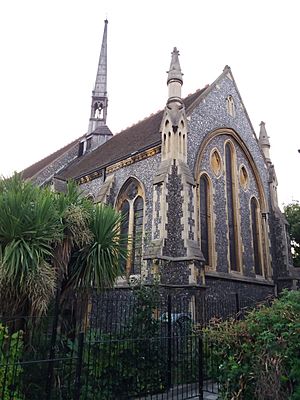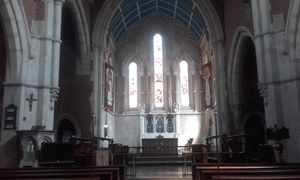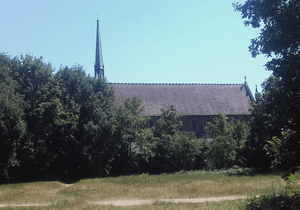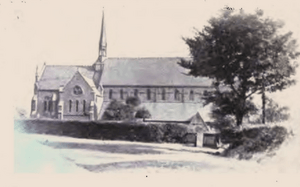St Andrew's Church, Leytonstone facts for kids
Quick facts for kids St Andrew's Church, Leytonstone |
|
|---|---|

View of the eastern end of St Andrew's Church
|
|
| Location | Colworth Road Leytonstone, London, E11 1JD |
| Country | England |
| Denomination | Church of England |
| Website | https://www.standrewsleytonstone.org/ |
| History | |
| Status | Active |
| Dedication | Andrew the Apostle |
| Dedicated | 1887 |
| Architecture | |
| Functional status | Parish church |
| Heritage designation | Grade II listed |
| Designated | 27 February 2006 |
| Architect(s) | Arthur Blomfield |
| Style | Early English Gothic |
| Years built | 1886–1893 |
| Administration | |
| Parish | St Andrew Leytonstone |
| Deanery | Waltham Forest |
| Archdeaconry | West Ham |
| Episcopal area | Barking |
| Diocese | Chelmsford |
| Province | Canterbury |
The Church of St Andrew in Leytonstone is a beautiful old church in East London. It was built during the Victorian era and is part of the Church of England. You can find it right next to Epping Forest. This church is so special that it's protected as a Grade II listed building, which means it's an important historical place.
Contents
Building a Community Church
The church stands on land that was once part of the Wallwood Estate. A rich banker named William Cotton bought this land in 1817. He was a very generous person who helped many charities. He even started three new churches in East End of London and gave money to over seventy others.
William Cotton passed away in 1866. His son, Sir Henry Cotton, sold the estate for new homes in 1874. However, he saved one piece of land next to Epping Forest. This land was set aside to build a new church in memory of his father.
Early Days and Construction
In 1882, a temporary church was put up on the land. It was made of corrugated iron and was sometimes called a "tin tabernacle." This temporary building was used for services while the main church was being planned. It was first called the Cotton Memorial Church.
William Manning became the first leader of the church in 1885. Work then began on a large new church. It was designed by a famous architect named Sir Arthur Blomfield. The Cotton family, the Bishop of St Alban's Fund, and the new church members all helped pay for it.
The first stone of the church was laid on June 18, 1886. A special ceremony took place with Prince Arthur, the Lord Mayor of London, and five bishops attending. Inside the stone, they placed a record of the building work and a copy of The Times newspaper.
Opening and Growth
The Cotton family paid for the chancel part of the church as a memorial to William Cotton. This part was built to a very high standard. The chancel and the first three sections of the nave were finished first. A temporary wall was put up so that the church could open for services.
The church was officially opened on April 30, 1887. It became its own separate church area on December 29, 1887. William Manning then became the first vicar, or priest, of the church. The church members worked hard to raise money to finish the rest of the building. The final part of the church was completed and dedicated on March 30, 1893.
St Andrew's quickly became very popular. By 1903, over 1,500 people attended services on Sundays. In 1904, a church hall was built next to the church. It was designed in the Arts and Crafts style. A vestry, which is a room for the clergy, was added in 1913.
Changes Over Time
By the late 1960s, fewer people were attending St Andrew's. To help the church continue, some changes were made. The old church hall was sold. In 1977, the western part of the church was separated from the main area by a tall wooden wall. One section was turned into a modern kitchen.
The old church hall was bought by the nearby Leytonstone School. Sadly, it burned down in 2002. Later, new apartments were built in its place. St Andrew's Church was given its Grade II listed building status on February 27, 2006. This means it is officially recognized as an important historic building.
In June 2007, Rowan Williams, who was the Archbishop of Canterbury, visited St Andrew's. He came with Eric Pickles, a government official. They visited because the church was working together with the nearby Shri Nathji Sanatan Hindu Mandir. The church is still active today.
Church Design and Features
The church is a large building designed in the Early English Gothic style. It is built using Kentish ragstone and freestone with knapped flint. There is a slender spire, called a flèche, over the middle part of the church.

The church has entrances on the west and north sides. There is a large chancel at the east end. A later vestry on the northeast side matches the church's style. The front of the church has a tall central window with two narrow windows and a round window above them. There are also tall, pointed decorations called pinnacles at the corners.
Inside, the walls are made of red brick with stone decorations. The chancel walls are made of smooth stone and have carvings. The stained glass windows at the east end were made in 1892. The wooden altar has a painted lamb and angels. The chancel roof is shaped like a barrel, and the nave roof has arched wooden beams. The original wooden pews and choir stalls are made of polished oak.
Beautiful Stained Glass Windows
Many of the stained glass windows in the nave were created by Margaret Chilton. She was a student of Christopher Whall. These windows were made between 1919 and 1957. The older windows, some of which remember soldiers from wars, are in the Arts and Crafts style. Her later work shows some expressionist influences, which means they have strong feelings and ideas. Together, these windows form the most important collection of her work in England.
The Church Organ
The church's pipe organ is based on an older instrument. It was brought to St Andrew's in 1889 from another church. In 1913, money was raised to fully rebuild the organ. A famous company called Lewis & Co did the work. The first concert on the rebuilt organ was on September 28, 1914.
A famous organist and composer named Healey Willan also gave a concert at St Andrew's. The organ was repaired in the 1990s and again in 2012. When the leather parts of the organ needed fixing, the choir and supporters held a "sponsored hymnathon." They sang every hymn in The English Hymnal for 31 hours straight to raise money!
St Andrew's Today

The parish of St Andrew Leytonstone is part of the Diocese of Chelmsford. It is the smallest parish in its area. The church follows a liberal Anglo-Catholic tradition, with the main service being the Sunday morning Eucharist.
The church building is used by many different community groups. These include a preschool, a group for senior citizens, and art classes. A Scout Group also meets there. Local councillors hold meetings, and teenagers can use the space to do their homework.


